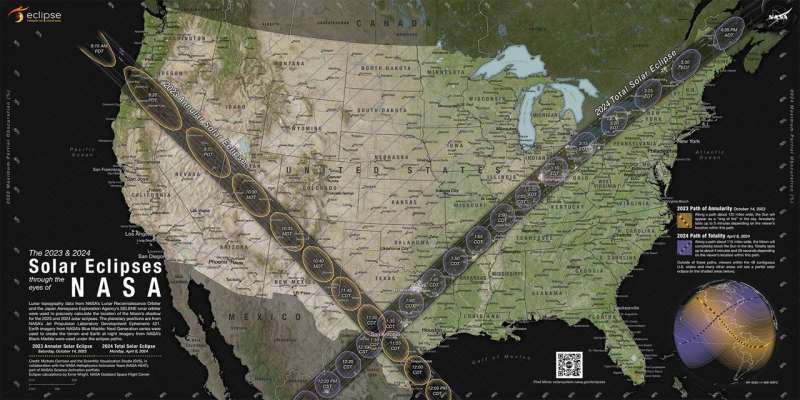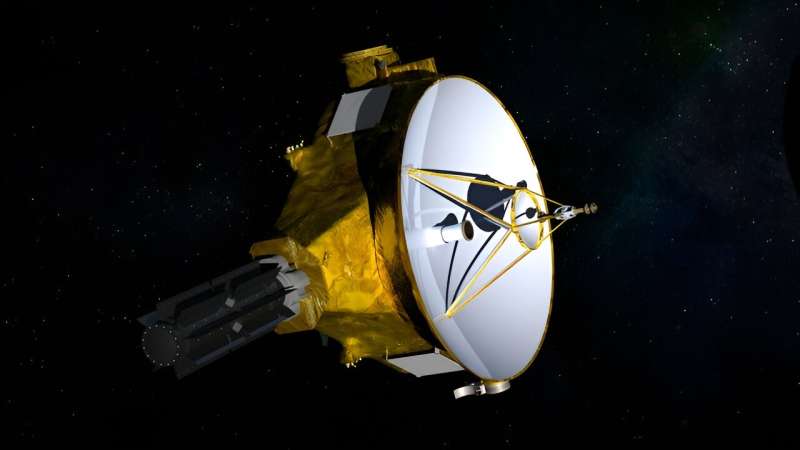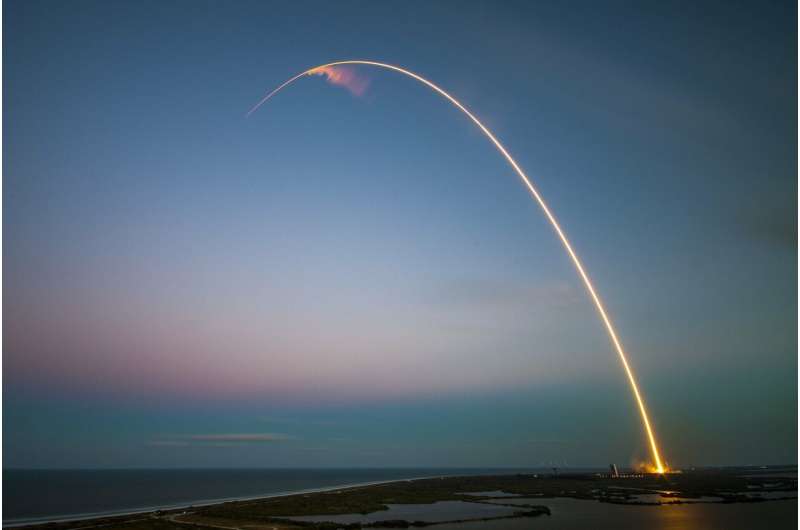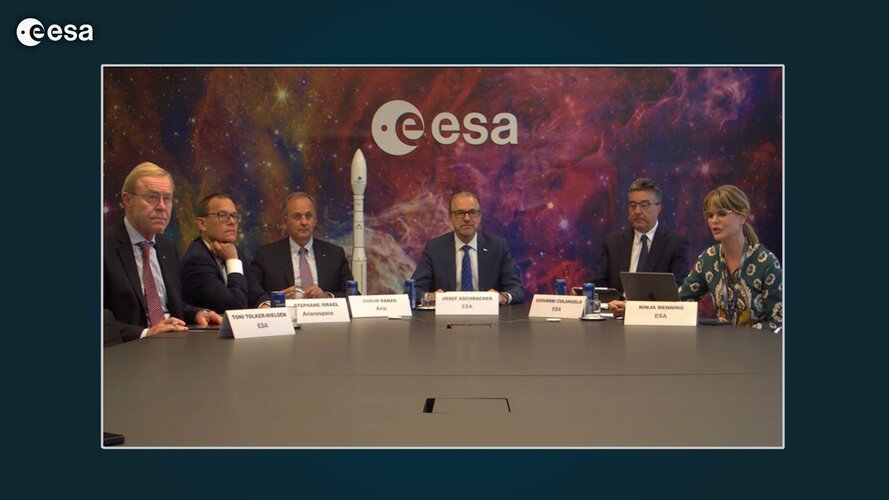
Copernical Team
To study atmosphere, NASA rockets will fly into October eclipse's shadow

A NASA sounding rocket mission will launch three rockets during the 2023 annular eclipse in October to study how the sudden drop in sunlight affects our upper atmosphere.
On Oct. 14, 2023, viewers of an annular solar eclipse in the Americas will experience the sun dimming to 10% its normal brightness, leaving only a bright "ring of fire" of sunlight as the moon eclipses the sun.
NASA's New Horizons to continue exploring outer solar system

NASA has announced an updated plan to continue New Horizons' mission of exploration of the outer solar system.
Beginning in fiscal year 2025, New Horizons will focus on gathering unique heliophysics data, which can be readily obtained during an extended, low-activity mode of operations.
While the science community is not currently aware of any reachable Kuiper Belt object, this new path allows for the possibility of using the spacecraft for a future close flyby of such an object, should one be identified. It also will enable the spacecraft to preserve fuel and reduce operational complexity while a search is conducted for a compelling flyby candidate.
"The New Horizons mission has a unique position in our solar system to answer important questions about our heliosphere and provide extraordinary opportunities for multidisciplinary science for NASA and the scientific community," said Nicola Fox, associate administrator for NASA's Science Mission Directorate in Washington. "The agency decided that it was best to extend operations for New Horizons until the spacecraft exits the Kuiper Belt, which is expected in 2028 through 2029.
SpaceX launches 69th orbital flight of the year with Canaveral liftoff

A SpaceX Falcon 9 took off for the 39th time from Cape Canaveral this year, marking the 49th SpaceX flight from the Space Coast and 69th orbital mission among all of its launch sites.
The rocket lifted off from Canaveral's Space Launch Complex 40 at 10 p.m. Friday after poor weather conditions delayed earlier attempts.
The first-stage booster made its 10th flight once again, making a recovery landing on the droneship A Shortfall of Gravitas in the Atlantic Ocean.
SpaceX has flown all but three of the Space Coast's 52 missions this year, with Relativity Space adding one and United Launch Alliance managing two more.
ULA, though, may have the next launch on tap as it announced a target liftoff of next Friday for an Atlas V rocket from neighboring Space Launch Complex 41 with a launch window that opens at 2 p.m.
Its payload is Amazon's first two test Project Kuiper satellites, which open the floodgates for ULA launches on a much more regular basis, as Amazon has purchased eight more Atlas rockets as well as 38 missions on its in-development Vulcan Centaur, which would together launch more than half of its planned 3,236-satellite constellation that would compete with the likes of SpaceX's Starlink.
Massive low-Earth orbit communications satellites could disrupt astronomy

Observations of the BlueWalker 3 prototype satellite show it is one of the brightest objects in the night sky, outshining all but the brightest stars.
Astronomers have raised concerns that without mitigation, groups of large satellites could disrupt our ability to observe the stars from Earth and perform radio astronomy.
Several companies are planning "constellations" of satellites—groups of potentially hundreds of satellites that can deliver mobile or broadband services anywhere in the world.
However, these satellites need to be in "low-Earth" orbit and can be relatively large, so their potential to disrupt night-sky observations is a concern.
Now, an international team of scientists led by astronomers from the IAU Center for the Protection of the Dark and Quiet Sky from Satellite Constellation Interference (CPS) and including Imperial College London researchers, have published a paper in Nature assessing the detailed impact of the prototype BlueWalker 3satellite on astronomy.
Media briefing: Findings of the Independent Enquiry Commission on Vega-C test
 Video:
00:42:00
Video:
00:42:00
Media briefing on the findings of the Independent Enquiry Commission tasked with analysing the results of the static-firing test of the Vega-C Zefiro 40 motor, which took place on 28 June 2023.
The press briefing was held on 2 October 2023 with ESA Director General Josef Aschbacher presenting the results of the investigation, with ESA Inspector General and chair of the Independent Enquiry Commission Giovanni Colangelo; Avio CEO Giulio Ranzo, Arianespace CEO Stéphane Israël, and ESA’s Director of Space Transportation Toni Tolker-Nielsen.
During the briefing, ESA and its partners presented the findings of the enquiry commission, together with an
Webb’s wide-angle view of the Orion Nebula is released in ESASky

New images of the Orion Nebula from the NASA/ESA/CSA James Webb Space Telescope have been included in ESA’s ESASky application, which has a user-friendly interface to visualise and download astronomical data.
German tech factory reveals antenna prototype-ngVLA will open a new window into the Universe
 Usually it's Octoberfest that draws a crowd to Germany this time of year. For hundreds of folks gathered at mtex antenna technology in Schkeuditz, it's a first look at a prototype radio telescope that may one day be part one of the world's largest and most sensitive radio telescopes in the world, the National Radio Astronomy Observatory's (NRAO) next generation Very Large Array (ngVLA). The prot
Usually it's Octoberfest that draws a crowd to Germany this time of year. For hundreds of folks gathered at mtex antenna technology in Schkeuditz, it's a first look at a prototype radio telescope that may one day be part one of the world's largest and most sensitive radio telescopes in the world, the National Radio Astronomy Observatory's (NRAO) next generation Very Large Array (ngVLA). The prot NASA selects four small explorer mission concept studies
 NASA has selected four small explorer missions to conduct concept studies. These studies aim to expand knowledge of the dynamics of the Sun and related phenomena, such as coronal mass ejections, aurora, and solar wind to better understand the Sun-Earth connection.
Any missions selected to move forward after the concept studies are conducted will join the current heliophysics mission fleet,
NASA has selected four small explorer missions to conduct concept studies. These studies aim to expand knowledge of the dynamics of the Sun and related phenomena, such as coronal mass ejections, aurora, and solar wind to better understand the Sun-Earth connection.
Any missions selected to move forward after the concept studies are conducted will join the current heliophysics mission fleet, Scientists prove that antimatter falls at the same rate as matter
 Early on in science classes all over the world, students drop diverse things to learn how gravity works and learn how outside forces might affect the rate of fall. But the science of falling goes well beyond the bowling ball and feather experiment. Einstein's theory of relativity is still being studied, applied and proven a multitude of ways today. For instance, the Antihydrogen Laser Physics Ap
Early on in science classes all over the world, students drop diverse things to learn how gravity works and learn how outside forces might affect the rate of fall. But the science of falling goes well beyond the bowling ball and feather experiment. Einstein's theory of relativity is still being studied, applied and proven a multitude of ways today. For instance, the Antihydrogen Laser Physics Ap Dust removal delayed: Sols 3962-3963
 Earth planning date: Wednesday, September 27, 2023: Our exploration of the light-and-dark-toned bands continues today as Curiosity has completed another successful drive and now has a promising block of light-toned bedrock in its latest workspace. With a thorough investigation of the compositions and textures within this region, we hope to identify what factors cause the differences between the
Earth planning date: Wednesday, September 27, 2023: Our exploration of the light-and-dark-toned bands continues today as Curiosity has completed another successful drive and now has a promising block of light-toned bedrock in its latest workspace. With a thorough investigation of the compositions and textures within this region, we hope to identify what factors cause the differences between the 